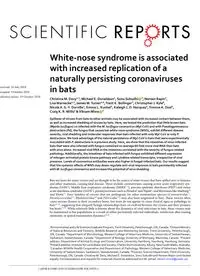
2018 White-nose syndrome is associated with increased replication of a naturally persisting coronaviruses in bats PDF
Preview 2018 White-nose syndrome is associated with increased replication of a naturally persisting coronaviruses in bats
1 SCIENTIFIC RepoRTs | (2018) 8:15508 | DOI:10.1038/s41598-018-33975-x www.nature.com/scientificreports White-nose syndrome is associated with increased replication of a naturally persisting coronaviruses in bats Christina M. Davy1,2, Michael E. Donaldson1, Sonu Subudhi 3, Noreen Rapin3, Lisa Warnecke4,5, James M. Turner4,6, Trent K. Bollinger7, Christopher J. Kyle8, Nicole A. S.-Y. Dorville4, Emma L. Kunkel4, Kaleigh J. O. Norquay4, Yvonne A. Dzal4, Craig K. R. Willis4 & Vikram Misra 3 Spillover of viruses from bats to other animals may be associated with increased contact between them, as well as increased shedding of viruses by bats. Here, we tested the prediction that little brown bats (Myotis lucifugus) co-infected with the M. lucifugus coronavirus (Myl-CoV) and with Pseudogymnoascus destructans (Pd), the fungus that causes bat white-nose syndrome (WNS), exhibit different disease severity, viral shedding and molecular responses than bats infected with only Myl-CoV or only P. destructans. We took advantage of the natural persistence of Myl-CoV in bats that were experimentally inoculated with P. destructans in a previous study. Here, we show that the intestines of virus-infected bats that were also infected with fungus contained on average 60-fold more viral RNA than bats with virus alone. Increased viral RNA in the intestines correlated with the severity of fungus-related pathology. Additionally, the intestines of bats infected with fungus exhibited different expression of mitogen-activated protein kinase pathway and cytokine related transcripts, irrespective of viral presence. Levels of coronavirus antibodies were also higher in fungal-infected bats. Our results suggest that the systemic effects of WNS may down-regulate anti-viral responses in bats persistently infected with M. lucifugus coronavirus and increase the potential of virus shedding. Bats are hosts for many viruses and are thought to be the source of some viruses that have spilled over to humans and other mammals, causing fatal disease. These include coronaviruses causing severe acute respiratory syn- drome (SARS1), Middle East respiratory syndrome (MERS2–5), porcine epidemic diarrhoea (PED6) and swine acute diarrhoea syndrome (SADS7); paramyxoviruses such as Hendra8 and Nipah9; and filoviruses like Marburg10 and Ebola11. Four families of viruses that are pathogenic for other mammalian species (Coronaviridae12, Paramyxoviridae13, Rhabdoviridae14 and Filoviridae15) may also have originated in bats. These viruses often cause serious disease in their secondary hosts, but most do not appear to cause clinical signs or pathology in bats16–18, suggesting that uniquely benign relationships have co-evolved between the viruses and their primary bat hosts19,20. While relatively little is known about the dynamics of viral infections in bats, these viruses may be maintained in bat populations as a result of either persistently infected individuals, reinfection after waning immunity, or spatial transmission dynamics21,22. 1Environmental and Life Sciences Graduate Program, Trent University, Peterborough, ON, Canada. 2Ontario Ministry of Natural Resources and Forestry, Wildlife Research and Monitoring Section, Trent University, Peterborough, ON, Canada. 3Department of Microbiology, Western College of Veterinary Medicine, University of Saskatchewan, Saskatoon, Saskatchewan, Canada. 4Department of Biology, University of Winnipeg, Manitoba, Canada. 5Present address: Department of Animal Ecology and Conservation, University Hamburg, Hamburg, Hamburg, Germany. 6Present address: Institute for Land Water and Society, Charles Sturt University, Albury, New South Wales, Australia. 7Canadian Wildlife Health Cooperative and Department of Pathology, Western College of Veterinary Medicine, University of Saskatchewan, Saskatoon, Saskatchewan, Canada. 8Forensic Science Department, Trent University, Peterborough, ON, Canada. Christina M. Davy, Michael E. Donaldson, Sonu Subudhi and Noreen Rapin contributed equally. Correspondence and requests for materials should be addressed to V.M. (email:
